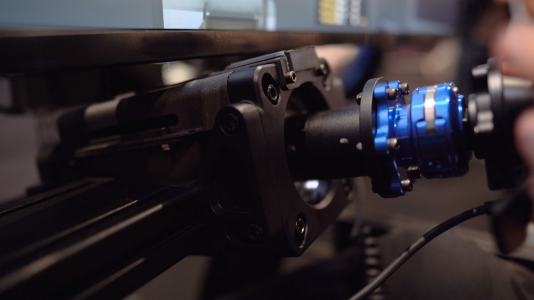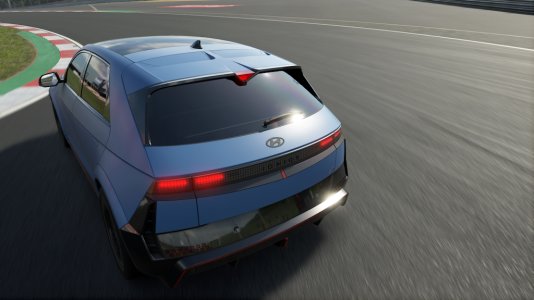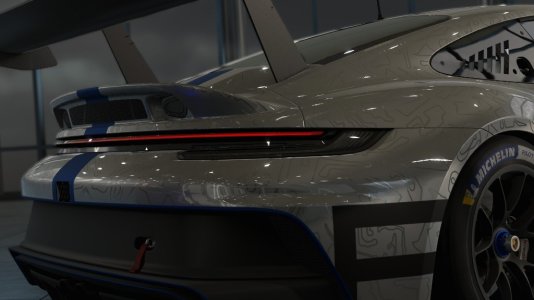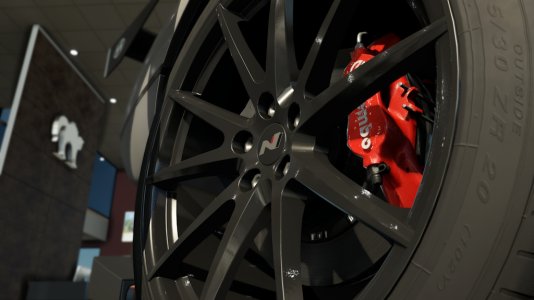You are using an out of date browser. It may not display this or other websites correctly.
You should upgrade or use an alternative browser.
You should upgrade or use an alternative browser.
The International Manufacturers Championship '67
- Thread starter IMC '67
- Start date
will this be released? if so is there a estimated date?
Two P-51 Mustangs and the Chaparral 2F of Mike Spence/Jim Hall at the 1967 12 Hours of Sebring. Phil Hill got appendicitis after qualy and Hall had to jump in for him for the race. The original game track had lots of Mustangs as well as WWII bombers but I've removed them all except for three Mustangs that will go as aviation air show participants.

I'm about to get out of the car and hand it over to my co-driver Hans Herrmann. We are currently running 8th overall and are leading the P2.0 class at the 1967 Daytona 24 hours. The real car finished 4th overall in the 1967 race and secured important points for Porsche in the top P+2.0 class (yes, that's how the rules worked if you finished in the top 6 overall) in the battle against Ferrari that would eventually be decided in the last round at Brands Hatch.
Herrmann is now strapped in the car and I'm following the pitstop progress over the shoulder of the chief mechanic. Viel Glück, Hans!
The car during a daylight pitstop at the 1967 Daytona 24 hours. Note the rear view cockpit mirror which is located so far to the right that I have to use the look right command to be able to see anything behind me.
Fun fact: during the Monza 1000 Kilometres, before the start of the race the orders were that Amon had to start the #3 Ferrari. Bandini refused because, he said, "we need to prove that we are faster than the Chaparral. It's going to break down, but if it does while they are in the lead, everyone will say that only reliability are holding them back and that they are faster than us. We need to prove they are not."
So he started, pushed and overtook the Chaparral... before it did break down
Yup.
(Bandini is in front and I'm driving the other P4).
And speaking of breakdowns, I'm currently working on improving how the AI handles reliability which will be another "game changer" for anyone who cares about realism. Although it takes time testing the various values with various cars, it's something that anyone can do for their own games if they have got tired of that most AI retirements occur during a pitstop and are then listed as a DNF. With the values I'm using, a vast majority of the mechanical AI retirements now occur on track and are then listed accordingly as Engine, Suspension, Gearbox, and Brakes in the Timing screen. There will still be a few listed as DNFs but that is realistic as not all causes were known during or just after a race. A cool thing with those listed DNFs is that if you start the Accelerated Time function after the race, the DNFs will turn into specified causes after a while like if the causes were discovered and communicated a couple of hours later!

Ferrari mechanics (and Pedro himself) working on the Rodriguez/Guichet 412P out on the track during the 1967 Daytona 24 hours race
So, here are some good starting values to try in the .eng files:
Low reliability:
LifetimeAvg=10000 // average lifetime in seconds
LifetimeVar=10000 // lifetime random variance
Medium reliability:
LifetimeAvg=15000 // average lifetime in seconds
LifetimeVar=15000 // lifetime random variance
High reliability:
LifetimeAvg=20000 // average lifetime in seconds
LifetimeVar=20000 // lifetime random variance
The values are supposed to be in seconds but I don't know about that since then no one would see the checkered flag in a 24 hours race. I have between 1/3 and 2/3 of the cars finishing a race in my game, just like the real 1967 season. I believe the variance value means +/- so if the average lifetime value is 20000, then the variance in lifetime is between 0 and 40000. If you test to set both values to 1, the car will break down within seconds after the start.

The Rodriguez/Guichet Ferrari 412P would eventually be fixed and go on and take 3rd place in the race. And dig the Volvo Amazon passing by in two of the pics!

Ferrari mechanics (and Pedro himself) working on the Rodriguez/Guichet 412P out on the track during the 1967 Daytona 24 hours race
So, here are some good starting values to try in the .eng files:
Low reliability:
LifetimeAvg=10000 // average lifetime in seconds
LifetimeVar=10000 // lifetime random variance
Medium reliability:
LifetimeAvg=15000 // average lifetime in seconds
LifetimeVar=15000 // lifetime random variance
High reliability:
LifetimeAvg=20000 // average lifetime in seconds
LifetimeVar=20000 // lifetime random variance
The values are supposed to be in seconds but I don't know about that since then no one would see the checkered flag in a 24 hours race. I have between 1/3 and 2/3 of the cars finishing a race in my game, just like the real 1967 season. I believe the variance value means +/- so if the average lifetime value is 20000, then the variance in lifetime is between 0 and 40000. If you test to set both values to 1, the car will break down within seconds after the start.
The Rodriguez/Guichet Ferrari 412P would eventually be fixed and go on and take 3rd place in the race. And dig the Volvo Amazon passing by in two of the pics!
They are in seconds. It's how much time outside of "normal" parameters the engine has spent as modified by oil temperature. So if you stick to a safe rev limit (as specified in the file) and don't overheat, the engine will last forever.The [engine] values are supposed to be in seconds but I don't know about that since then no one would see the checkered flag in a 24 hours race.
Here's the rFactor description from Bristow's Bible as posted on Race Sim Central starting in 2007 and last edited in 2009 before RSC crashed without backups:
Once upon a time, I made a spreadsheet that would calculate this stuff so you could make predictions, but I haven't found it in a long while.LifetimeEngineRPM=(17730.0,344.0) // (base engine speed for lifetime, range where lifetime is halved)
LifetimeOilTemp=(125.4,2.90) // (base oil temp for lifetime, range where lifetime is halved)
LifetimeAvg=8105 // average lifetime in seconds
LifetimeVar=2940 // lifetime random variance
This section calculates the engine life dependant on rpm, oil temperature relative to optimum, and statistical treatment of average life. The following is from ISI, courtesy of Maxsilver. I have edited the original to fit with the numbers in this file -
"The LifetimeAvg and LifetimeVar are ... the mean and one standard deviation of a normal distribution.
The lifetime of the engine is continually reduced based on the current RPM and temperature. If you were able to drive around perfectly maintaining an RPM of 17730.0 and oil temp of 125.4 deg C, the lifetime would reduce by 1 every second. So on average, you'd have 8105 seconds before your engine exploded.
Now obviously you can't maintain that exact RPM & temp, so the lifetime reduction happens faster if you're above the RPM & temp and slower if you're below. It's an exponential curve - at 17730.0 + 344.0 RPM and 125.4 + 2.90 deg C, the lifetime reduces by 2 every second. At 17730.0 + (2 * 344) and 125.4 + ( 2 * 2.90) deg C, the lifetime reduces by 4 every second, etc. The RPM and temperature each contribute half to the calculated lifetime reduction."
The section in italics at the beginning of that quote is a later explanation provided by ITT based on some correspondence with ISI. So the engine lifetime fits a normal distribution in the statistical meaning of that term. 68% of engine lives will fit within LifetimeAvg ± LifetimeVar, and 98% within LifetimeAvg ± 2 x LifetimeVar, all modified by the RPM and temperature effects.
Last edited:
Davide Nativo
Premium
Does scaling mechanical failures affect this?They are in seconds. It's how much time outside of "normal" parameters the engine has spent as modified by oil temperature. So if you stick to a safe rev limit (as specified in the file) and don't overheat, the engine will last forever.
Here's the rFactor description from Bristow's Bible as posted on Race Sim Central starting in 2007 and last edited in 2009 before RSC crashed without backups:
Once upon a time, I made a spreadsheet that would calculate this stuff so you could make predictions, but I haven't found it in a long while.
That rFactor description is a bit over my skill levels but so far I've got very authentic/realistic 1967 AI results with the values I'm using and that's what counts in my book.
The LifetimeAvg and LifetimeVar parameters doesn't just affect the player car engine but also affect the occurence of other mechanical failures for the AI, like suspension, gearbox, and brakes as well as their engine longevity.
The LifetimeEngineRPM is an important parameter for the player car but doesn't affect the AI cars.
And this is GTR2 which might differ from rFactor.
The LifetimeAvg and LifetimeVar parameters doesn't just affect the player car engine but also affect the occurence of other mechanical failures for the AI, like suspension, gearbox, and brakes as well as their engine longevity.
The LifetimeEngineRPM is an important parameter for the player car but doesn't affect the AI cars.
And this is GTR2 which might differ from rFactor.
These are questions that one 'Ian Bell' a member of this very site may well be able to answer, I personally would love a definative explanation even though one worked out by another member of the site seems right, there's nothing like a 'from the horses mouth' answer.
Davide Nativo
Premium
As if he actually has any clue about it
Yes.Does scaling mechanical failures affect this?
Also well worth mentioning here is the very important WheelDetach parameter found in the cars' .dmg files which affects both the player car and the AI cars. Lower values will make the wheels to more easily get detached at contact between a car and an object. The cause of retirement will then be listed as "Accident" in the Timing screen. A good starting value here is between 10000 and 11000.
I also use the WheelDetach parameter in the game's career option as a measure for the player's health condition after a crash. So, if you crash your car, you'll be in the risk of not being able to participate in the next race/races or even have to start your lifelong game career all over again if you die in the accident. The level of injuries are being measured by how many of your car's wheels that gets detached in the crash, one wheel = not being able to participate in the next race, two wheels = the rest of the season, three or four wheels = death.
And here are my WIP career rules and regulations for the various types of damage regarding the car's "health" condition:
3.2. CAR DAMAGE
I also use the WheelDetach parameter in the game's career option as a measure for the player's health condition after a crash. So, if you crash your car, you'll be in the risk of not being able to participate in the next race/races or even have to start your lifelong game career all over again if you die in the accident. The level of injuries are being measured by how many of your car's wheels that gets detached in the crash, one wheel = not being able to participate in the next race, two wheels = the rest of the season, three or four wheels = death.
And here are my WIP career rules and regulations for the various types of damage regarding the car's "health" condition:
3.2. CAR DAMAGE
3.2.1. BODY DAMAGE
Can be repaired in the pits during a current session (practice, qualifying, and race).
3.2.2. BRAKE DAMAGE (Worn out brake pads)
Can be replaced in the pits during a current session.
3.2.3. SUSPENSION DAMAGE
Can be repaired in the pits during a current session but the player will have to be able to drive back the car to the pits. (If the car is for example stuck in a sand bank, session is also over for the player).
3.2.4. ENGINE DAMAGE (Stalled engine that will not restart)
Session is over for the player as it will not be possible to repair the engine during the session. If the player manages to damage the engine in both qualifying sessions before having set a lap time, the sessions will not be counted and the grid for AI competitors will be based on the real 1967 grid with the player starting last. (Untick the qualifying boxes and set player starting position to last in the Summary screen).
3.2.5. DETACHED WHEEL(S) (Simulating heavy, non-repairable during race weekend, damage to the car)
This means that the player's car will not be able to start the race. Race will not be held in game and points will be awarded to the AI competitors using the real 1967 race results but not including the real player car.
Davide Nativo
Premium
Seems a bit excessive to me, considering that drivers often escaped severe crashes with none or minor injuries and, despite the bad rap motorsports get regarding safety, the number of deaths compared to the number of races held and participants that took part is very small.
I would go with 1=null, 2-3=medium to no consequences, 4=severe to death
The possible outcome would have to be decided by an algorithm, if that is even possible to implement, with a formula that picks a random result out of a pool of possibilities within the specified range
I would go with 1=null, 2-3=medium to no consequences, 4=severe to death
The possible outcome would have to be decided by an algorithm, if that is even possible to implement, with a formula that picks a random result out of a pool of possibilities within the specified range
Last edited:
I use similar though not integrated rules in my own racing, as, with crashing in a session to me means session over for the player (me) and a heafty crash would mean starting at the back of the grid with a first lap stop to check all is well.
This is obviously on longer 1-3 hour races, I find that I'm able to abide by my own rules, driving every lap, in and out, in all games and sims and not exploiting cheats just because I can, for instance, say in Skyrim I would travel by road* and never use the fast travel system.
For me it adds to the immersion and because GTR2 is so detailed I feel more for the sim than any other I've tried.
But I do wish the AI would get some of that crash damage fixed in the pits, that would add a bit more
* where appropriate, boat, and obviously need teleport to the magical places.
This is obviously on longer 1-3 hour races, I find that I'm able to abide by my own rules, driving every lap, in and out, in all games and sims and not exploiting cheats just because I can, for instance, say in Skyrim I would travel by road* and never use the fast travel system.
For me it adds to the immersion and because GTR2 is so detailed I feel more for the sim than any other I've tried.
But I do wish the AI would get some of that crash damage fixed in the pits, that would add a bit more
* where appropriate, boat, and obviously need teleport to the magical places.
Seems a bit excessive to me, considering that drivers often escaped severe crashes with none or minor injuries and, despite the bad rap motorsports get regarding safety, the number of deaths compared to the number of races held and participants that took part is very small.
I would go with 1=null, 2-3=medium to no consequences, 4=severe to death
The possible outcome would have to be decided by an algorithm, if that is even possible to implement, with a formula that picks a random result out of a pool of possibilities within the specified range
It's almost impossible to detach more wheels than two in a crash. Even two wheels are very unlikely and have only happened to me a couple of times in hundreds of crashes. In a vast majority of all my crashes, no wheels at all gets detached, meaning no health consequences for the player.
Latest News
-
Racing Club Schedule: November 17 - 24A new week means a new set of events in our Racing Club. Here's what's on tap from November 17...
- Yannik Haustein
- Updated:
- 3 min read
-
Macau Grand Prix in Sim Racing: Deserving of More?This weekend is the Macau Grand Prix and whilst a shadow of its former self, this tight street...
- Angus Martin
- Updated:
- 3 min read
-
How One Announcement Quadrupled Forza Horizon 4's Player BaseIt is exactly one month until Forza Horizon 4 will no longer be available to purchase online...
- Angus Martin
- Updated:
- 2 min read
-
Assetto Corsa EVO New Car Configurator In The PipelineAfter this year's sim Racing Expo, the excitement around Assetto Corsa EVO has continued to...
- Connor Minniss
- Updated:
- 2 min read
-
Steering Wheel Showdown: Which Wheel Would You Like A Sim Racing Version Of?Sim racers have plenty of choice when it comes to hardware. There are a number of cool steering...
- Yannik Haustein
- Updated:
- 2 min read
-
Gran Turismo 7: Yamauchi Teases New Cars For Update 1.53It is that time again when Gran Turismo series producer Kazunori Yamauchi teases us with an...
- Luca Munro
- Updated:
- 5 min read
-
Automobilista 2: Incoming DLC Will Have Free Trial PeriodWith the big v1.6 update, plenty of new content is coming to Automobilista 2. Players who are on...
- Yannik Haustein
- Updated:
- 2 min read










